
Paula Radcliffe’s Three Key Running Metrics and the Marathon World Record
“What kind of training should I do? What performance improves with this workout? I’m not feeling much effect—do I still need to do it?”
These are some of the most common questions people ask about training. The frequency of such questions suggests that the effects of training aren't always immediately noticeable. It may take a long time to feel the benefits physically, and in some cases, your data might show improvement even if your body doesn’t seem to.
By looking at the data of Paula Radcliffe, the world-record-holding women's marathoner of the early 2000s, we can see how various performance metrics changed and improved through training.
Paula Radcliffe (referred to as PR hereafter) is a British marathon runner and one of the most outstanding athletes in the sport's history. She won seven major marathons, and her women's world marathon record of 2:15:25, set at the London Marathon in April 2003, stood unbroken for 16 years until 2019. Researchers tracked PR’s physiological data from 1992 to 2003. Let’s examine how these metrics evolved leading up to her world record, based on the findings from that study.
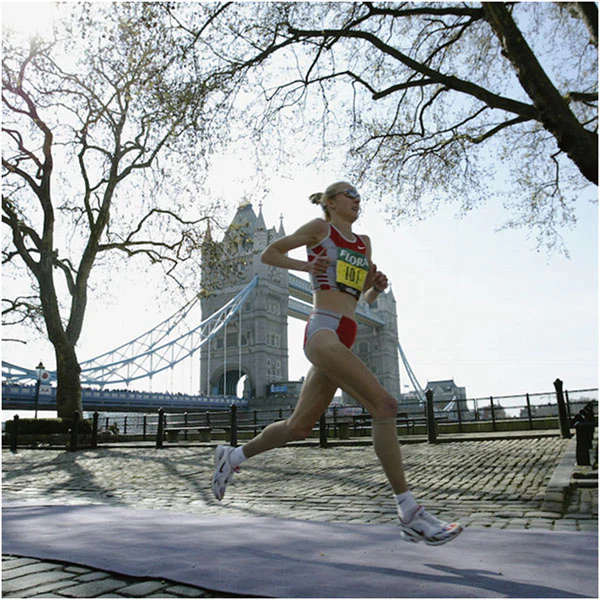
Key Physiological Metrics Evaluated in PR
“Endurance” can be defined as the ability to sustain exercise at a given speed for as long as possible. Because endurance sports require energy over extended periods, the ability to supply energy continuously is crucial. In this process, most energy is generated through oxidative metabolism, which relies on sufficient oxygen supply. Therefore, the study evaluated three key physiological metrics related to oxygen supply and utilization to assess PR’s endurance capacity: VO₂max, RE (Running Economy), and LT (Lactate Threshold). VO₂max refers to the maximum amount of oxygen the body can utilize. Higher oxygen intake allows for greater energy production, making VO₂max a critical factor in endurance performance. Elite male athletes typically have a VO₂max of 70–85 mL/kg/min, while elite female athletes range from 60–75 mL/kg/min. RE is defined as the amount of oxygen consumed at a given running speed. It varies significantly between individuals—even among elite athletes. If less oxygen is required to maintain a certain pace, it indicates more efficient oxygen utilization. Lower RE is better, as it helps reduce muscle glycogen consumption and lowers the risk of metabolic acidosis. LT (Lactate Threshold) marks the point where blood lactate levels begin to rise sharply. Lactate is a byproduct of anaerobic metabolism, produced when aerobic energy production is insufficient at higher intensities. As lactate accumulates, muscle contraction becomes impaired, making LT a valuable indicator of endurance capacity.
Changes in PR’s Three Key Running Metrics
Researchers used a treadmill test that progressively increased in speed every 3 minutes to measure PR’s running metrics. VO₂max was measured as the peak oxygen intake during the test, RE was determined by oxygen consumption at 16 km/h—PR’s typical endurance training pace—and LT was calculated from blood samples taken during each stage.
This testing protocol was repeated consistently over 12 years, and researchers observed unique patterns of change in the data.
VO₂max showed some minor fluctuations but remained around 70 mL/kg/min from 1992, when PR was 18 years old, until 2003 when she set the world record. No significant improvement was observed in VO₂max—already at a world-class level—and in fact, her VO₂max in 2003 was slightly lower than it had been two years earlier.
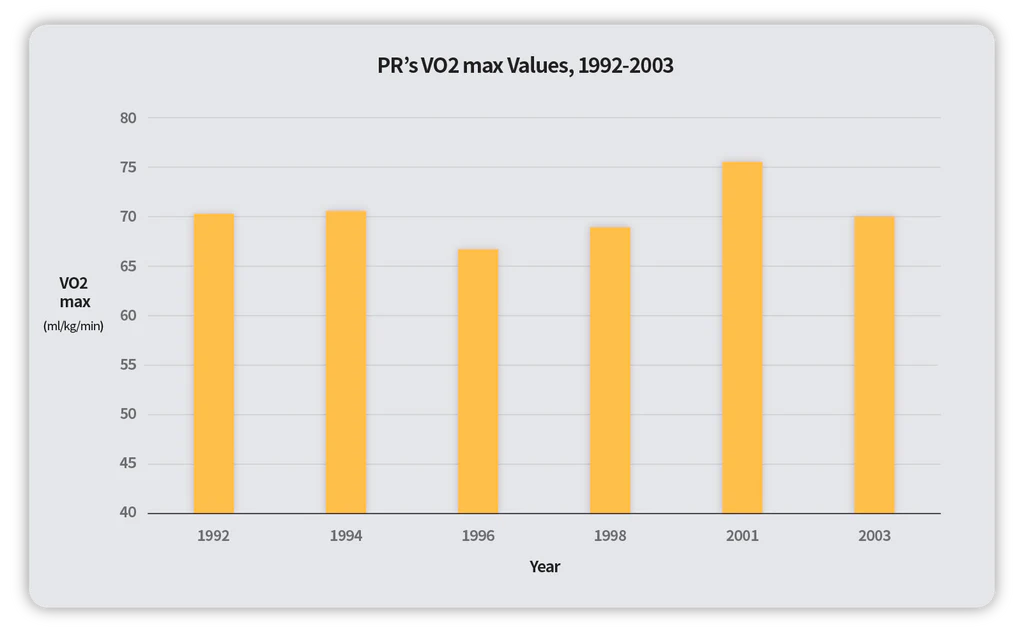 In contrast, RE steadily improved from 1992 to 2003. Oxygen consumption per kilometer dropped from 205 mL/kg/km in 1992 to 175 mL/kg/km in 2003—a roughly 15% improvement over time. Remarkably, even as VO₂max stayed the same or slightly decreased, PR's running speed at VO₂max increased significantly. This was attributed to her improved RE, which compensated for the lack of VO₂max gains.
In contrast, RE steadily improved from 1992 to 2003. Oxygen consumption per kilometer dropped from 205 mL/kg/km in 1992 to 175 mL/kg/km in 2003—a roughly 15% improvement over time. Remarkably, even as VO₂max stayed the same or slightly decreased, PR's running speed at VO₂max increased significantly. This was attributed to her improved RE, which compensated for the lack of VO₂max gains.
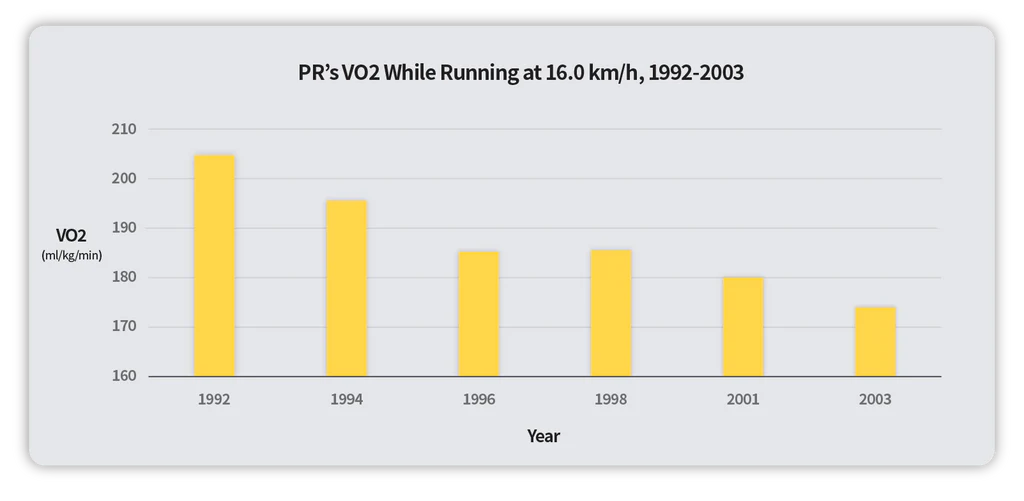
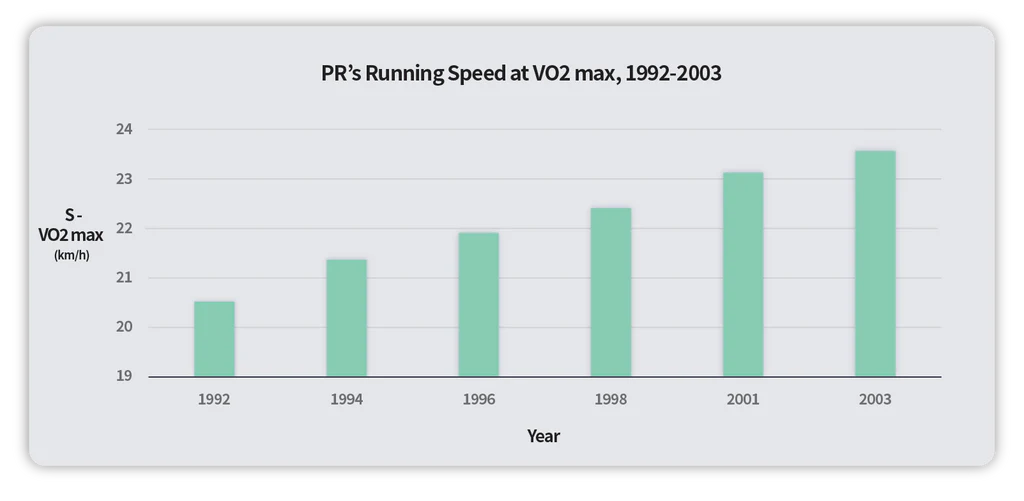 LT and LTP (Lactate Turn Point) also improved. Researchers concluded that these gains
were results of training. As PR’s maximum running speed increased, she was able to
train at higher intensities and with higher quality, contributing to improved LT
performance.
LT and LTP (Lactate Turn Point) also improved. Researchers concluded that these gains
were results of training. As PR’s maximum running speed increased, she was able to
train at higher intensities and with higher quality, contributing to improved LT
performance.
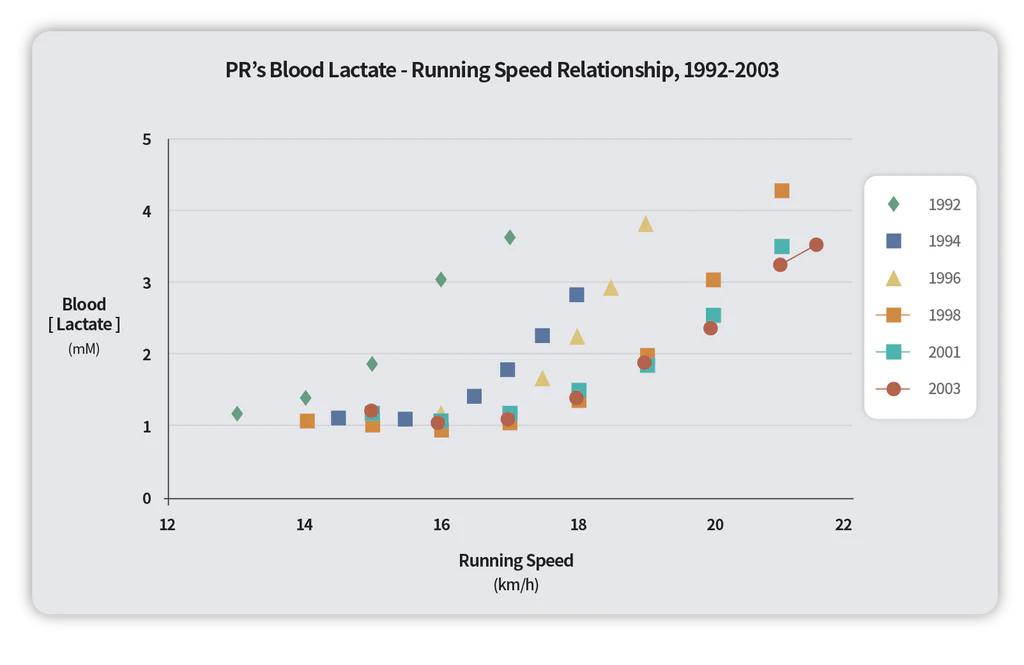
Insights from PR’s Case
It appears that improvements in RE played a central role in PR’s endurance performance gains. However, RE itself is influenced by many factors, and pinpointing the exact cause of her improvements is difficult. Aerobic capacity enhancement involves a complex combination of physiological adaptations. Because of this, the researchers emphasized the importance of high-quality training. PR placed great value not just on training volume but also on its quality, consistently maintaining high standards. Through regular testing, she monitored physiological changes and assessed her overall fitness and health. She then adjusted her training intensity based on this data. This continuous feedback and adjustment led to better training efficiency, which in turn resulted in reduced blood lactate accumulation, improved oxygen utilization, and overall enhancements in aerobic capacity.
Conclusion
It can take a long time for the effects of training to become noticeable. You may not feel the difference right away. However, checking your data and continuing to train steadily is important. By fine-tuning your training to match your current condition, you can achieve gradual, long-term improvements.